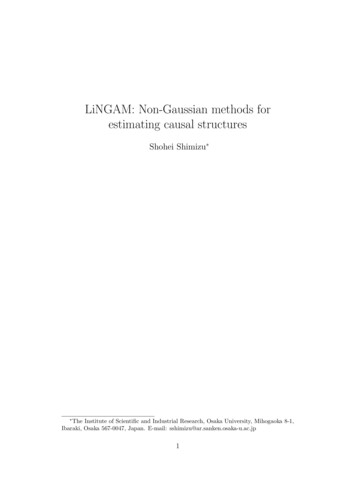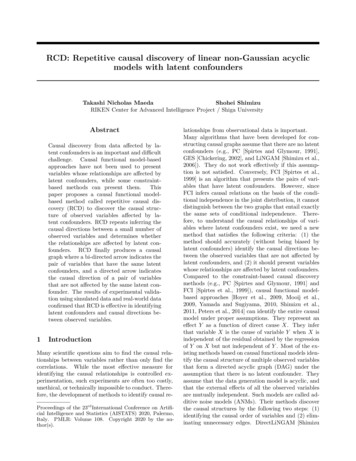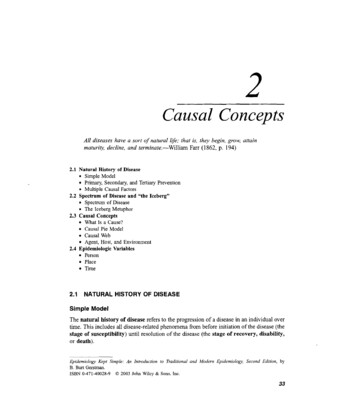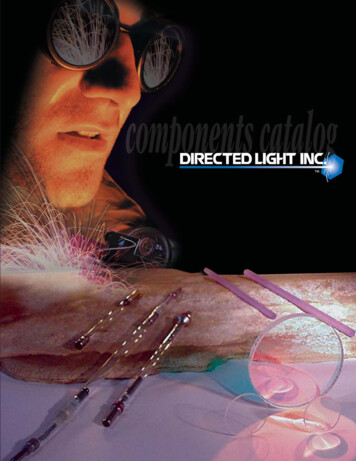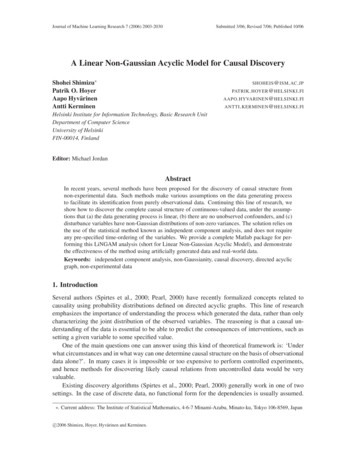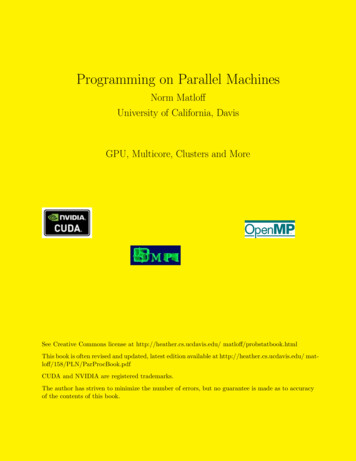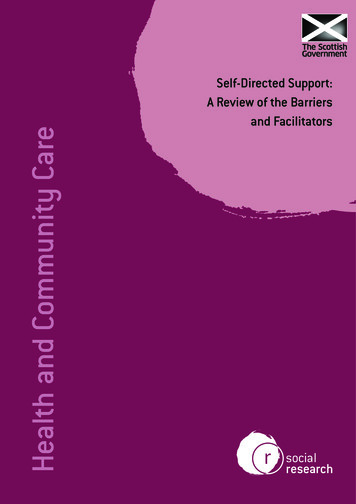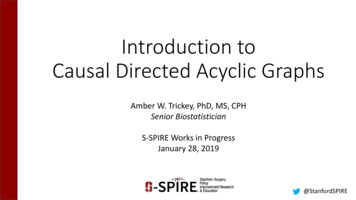
Transcription
Introduction toCausal Directed Acyclic GraphsAmber W. Trickey, PhD, MS, CPHSenior BiostatisticianS-SPIRE Works in ProgressJanuary 28, 2019@StanfordSPIRE
Overview What are DAGs & why do we need them? DAG rules & conventions How to construct a DAG Which variables should be included? How to determine covariates for adjustment? Examples: manual DAG online tool Build your own DAG
Observational Health Services Research Big HSR datasets are observational MedicareHCUP: NIS, NEDS, NRD, SIDsTruven, OptumEMR: STARRClinical Registries: NSQIP, VQI Observational comparative effectiveness 1 Treatments not assigned, determined by mechanisms of routine practice Actual mechanisms are often unknown However researchers can (and should) speculate on the treatment assignmentprocess or mechanism Problem: correlation causation1 2013AHRQ Developing a protocol for observational comparative effectiveness research: a user's guide
Causal Graphs: Helpful Tools1. Illustrate sources of bias2. Determine whether the effect of interestcan be identified from available data3. Causal graphs are based on assumptions(but so are analytic models)
What are Directed Acyclic Graphs? Computer science: data structureC1 Markov models: visualization Epidemiology: Causal DAGs aresystematic representation of causalrelationships Useful tools to representassumptions & known relationships plan analytic approach reduce biasC2A?Y
Directed & Acyclic Directed: point from cause to effect Causal effects cannot be bidirectional Acyclic: no directed path can form a closed loopNO:YES: C1C2A?YAC?Y
Why do we need DAGs? Clarify study question & relevant concepts Explicitly identify assumptions Reduce bias Separate individual effects Ascertain appropriate covariates for statistical analysis Estimate required analysis timeWe can assist with DAG creation and covariate assessment
DAG Rules All common causes are represented No arrow no causal effect Time flows left to right A (or E) Exposure / Treatment / Intervention / Primary IV Y (or D) Outcome C Covariates / Confounders U Unmeasured relevant variables Confounders can be grouped for notation
Glossary – Genealogy Parent: a direct cause of a particular variable Ancestor: a direct cause (i.e. parent) or indirectcause (e.g. grandparent) of a particular variable Child: the direct effect of a particular variable, i.e.the child is a direct effect of the parent Descendant: a direct effect (i.e. child) or indirecteffect (e.g. grandchild) of a particular variable Common Cause: a covariate that is an ancestor oftwo other dchild
How to Construct a DAG:Variables to Include
How to construct a DAGStep 1: Articulate the research question Start the DAG with your: A / treatment / exposure / primary IV (cause) Y / dependent variable / endpoint / outcome (effect) Indicate the research question with a “?”Exposure / Treatment“Cause”A?Outcome / Disease“Effect”Y
How to construct a DAGStep 2: Consider important variables embedded in the question Mediator: a variable within Moderator: affects the directionthe causal pathway betweenand/or strength of the relationthe treatment and outcome.between A & Y (AKA effectTreatment (A) influences themodifier, statistical interaction)mediator, which in turn e.g. gender differences in surgicalhistory-opioid relationshipinfluences the outcome. Some disagreement on e.g. complications in frailtyreadmissions associationinclusion/notation in DAGs 2Exposure / Treatment“Cause”AModeratorModeratorx Treatment?MediatorOutcome / Disease“Effect”Y
How to construct a DAGStep 3: Consider confounding variables Variables that confound the relationship you are evaluating Confounders are causes of both the treatment (A) & theoutcome e.g. age, gender, race, insurance Add confounders to DAG, considering causal mechanismConfounderCause both Exposure & OutcomeExposure / Treatment“Cause”A?Outcome / Disease“Effect”Y
How to construct a DAGStep 4: Consider other relevant variablesWhich Variables Should be Included? All common causes of any 2 variables in the DAG Unmeasured (and unmeasurable) common causes Selection variables, i.e. inclusion criteriaNot Required in Causal DAGs: Variables that cause Y but not A May be included if desired, e.g. for comparison to otherstudies which adjusted for the variable
Example: Uncomplicated Appendicitis3InsuranceAgeAppendicitisCNO MODERATORSor onoperativeManagementA?30-dayED VisitsYStep 1:Research QStep 2:Med/ModsStep 3:ConfoundsStep 4:Others
Example: Uncomplicated agementA?IncomeU30-dayED VisitsY
Keep in mind Assumptions must be made Every analysis has built-in assumptions DAGs make them explicit, represent your model ofrelationships between variables Often more than 1 appropriate DAG Alternate DAGs can make excellent sensitivity analyses
How to Construct a DAG:Determine Covariates for Adjustment
Glossary – Causes, Effects, Associations Back Door Path: a connection between A & Y that does not followthe path of the arrows. Common Effect (also known as Collider): a covariate that is adescendant of two other covariates. The term collider is used becausethe two arrows from the parents "collide" at the descendant node. Conditioning: Conditioning on a variable means using either samplerestriction, stratification, adjustment or matching to examine theassociation of A & Y within levels of the conditioned variable. Other terms "adjusting" or "controlling" suggest a misleadinginterpretation of the statistical model. 4
Back Door PathAppendicitisSeverityCNonoperativeManagementA A connection between A & Y that doesnot follow the path of the arrows. Open back door path confounding bias,i.e. association b/t A & Y causal U30-dayED VisitsY
Common Effector tA A covariate descendant of twoother covariates. Two arrows from the parents"collide" at the descendant node.Insurance,AgeCPrimaryNO COLLIDERSLanguageC?GenderCIncomeU30-dayED VisitsY
ConditioningConditioning can mean: adjusting, restricting, stratifying, matchingDraw a box around the conditioned variables1. Conditioning on a variable in an open backdoor pathremoves the non-causal association (i.e. controls for2.3.confounding)Conditioning on a collider opens the path that thecollider was blockingConditioning on a variable in the causal pathway(mediator) removes part of the causal effect
ementARemaining potential confounding dueto unmeasured language & U30-dayED VisitsY
Collider Bias Example: Surgery for Low Back gicalReadinessA?ChangeinPainY
Glossary – Structural Approach to Bias Confounding bias: common cause of A & Y that is not "blocked“ byconditioning on other specific covariates Collider bias: general phenomenon involving conditioning oncommon effects. Selection bias: a particular type of collider bias in which the commoneffect is selection into the study; occurs when a common effect isconditioned such that there is now a conditional association betweenA & Y (e.g. Berkson's Bias, loss to f/u, missing data, healthy worker bias) Berkson’s bias: a particular type of selection bias in which selection ofcases into the study depends on hospitalization, and the treatment isanother disease, or a cause of another disease, which also results inhospitalization 5
Online Tool www.dagitty.net6Save your code!(.docx or .txt)
Summary: AHRQ CER User’s GuideGuidance7Key ConsiderationsDevelop a simplified Use a DAG to illustrate and communicate known sourcesDAG to illustrateof bias, such as important well known confounders andconcerns about bias.causes of selection bias.Develop complete Construction of DAGs should not be limited to measuredDAG(s) to identify avariables from available data; they must be constructedminimal set ofindependent of available data.covariates. The most important aspect of constructing a causal DAGis to include on the DAG any common cause of any other2 variables on the DAG. Variables that only causally influence 1 other variable(exogenous variables) may be included or omitted fromthe DAG, but common causes must be included for theDAG to be considered causal. Identify a minimal set of covariates that blocks allbackdoor paths and does not inadvertently open closedpathways by conditioning on colliders or descendants.*Sauer,VanderWeele.“Supplement 2:Use of directedacyclic graphs."(2013).
Questions?Build your own DAG!
References1.Velentgas P, Dreyer NA, Nourjah P, Smith SR, Torchia MM, editors. Developing a protocol for observationalcomparative effectiveness research: a user's guide. Government Printing Office; 2013 Feb 21.2.Weinberg CR. Can DAGs clarify effect modification?. Epidemiology 2007 Sep;18(5):569.3.Sceats LA, Trickey AW, Morris AM, Kin C, Staudenmayer KL. Nonoperative Management of Appendicitis: ARetrospective Cohort Analysis of Privately Insured Patients. JAMA Surgery, in press.4.Shrier I, Platt RW. Reducing bias through directed acyclic graphs. BMC medical research methodology. 2008Dec;8(1):70.5.Pearce N, Richiardi L. Commentary: three worlds collide: Berkson’s bias, selection bias and collider bias.International journal of epidemiology. 2014 Feb 28;43(2):521-4.6.Textor J, van der Zander B, Gilthorpe MS, Liśkiewicz M, Ellison GT. Robust causal inference using directedacyclic graphs: the R package ‘dagitty’. International journal of epidemiology. 2016 Dec 1;45(6):1887-94.7.Sauer B, VanderWeele TJ. "Use of directed acyclic graphs." In: Velentgas P, Dreyer NA, Nourjah P, Smith SR,Torchia MM, editors. Developing a protocol for observational comparative effectiveness research: a user'sguide. Government Printing Office; 2013 Feb 21.8.Greenland S, Pearl J, Robins JM. Causal diagrams for epidemiologic research. Epidemiology. 1999 Jan 1:37-48.9.LaCalle E, Rabin E. Frequent users of emergency departments: the myths, the data, and the policyimplications. Annals of emergency medicine. 2010 Jul 1;56(1):42-8.
Additional Resources1.Howards PP, Schisterman EF, Poole C, Kaufman JS, Weinberg CR. “Toward a clearer definition ofconfounding” revisited with directed acyclic graphs. American journal of epidemiology. 2012 Aug17;176(6):506-11.2.Williams TC, Bach CC, Matthiesen NB, Henriksen TB, Gagliardi L. Directed acyclic graphs: a tool for causalstudies in paediatrics. Pediatric research. 2018 Jun 4.3.Suttorp MM, Siegerink B, Jager KJ, Zoccali C, Dekker FW. Graphical presentation of confounding in directedacyclic graphs. Nephrology Dialysis Transplantation. 2014 Oct 16;30(9):1418-23.4.Baron RM, Kenny DA. The moderator–mediator variable distinction in social psychological research:Conceptual, strategic, and statistical considerations. Journal of personality and social psychology. 1986Dec;51(6):1173.
Draw a box around the conditioned variables. 1. Conditioning on a variable in an open backdoor path removes the non-causal association (i.e. controls for confounding) 2. Conditioning on a collider opens the path that the collider was blocking 3. Conditioning on a variable in the causal pathway (mediator) removes part of the causal effect

